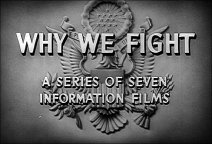
Made from 1942 to 1945, the seven films range from
40 to 76 minutes in length.
Intro
and Background to the series
|
1. Prelude
to War (1942) (51:35) - examines the difference between democratic
and fascist states, and covers the Japanese conquest of Manchuria and the
Italian conquest of Ethiopia.
Watch
Pt. I at Archive.org (Java script required)
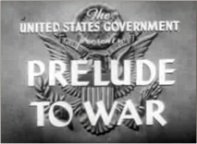 Part
I describes World War II as a battle between the "slave world" of fascism
and the "free world" of American liberty. In the "slave world," the entire
populations of Germany, Italy and Japan have been hoodwinked by madmen,
opportunists who capitalized on their people's desperation and weakness
to rise to power. These demagogues promised revenge for past losses, and
in the process convinced their people to give up their rights and accept
dictatorship. Part
I describes World War II as a battle between the "slave world" of fascism
and the "free world" of American liberty. In the "slave world," the entire
populations of Germany, Italy and Japan have been hoodwinked by madmen,
opportunists who capitalized on their people's desperation and weakness
to rise to power. These demagogues promised revenge for past losses, and
in the process convinced their people to give up their rights and accept
dictatorship.
In the "free world," the principles of equality, freedom,
and liberty characterize the greatest leaders, embodied in the works and
words of Washington, Jefferson, and Lincoln. This freedom is a threat to
the fascist dictators of the Axis powers, who claim that democracy is weak
and must be eradicated. The film claims that the ultimate goal of the Axis
powers is to enslave the nations of the "free world," a desire made manifest
in the Japanese invasion of Manchuria and Mussolini's destruction of Ethiopia.
|
2. The Nazis Strike
(1943) (40:20) - covers Nazi geopolitics and the conquest of Austria, Czechoslovakia
and Poland.
Watch
Pt. II at Archive.org
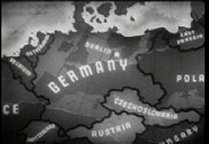 Chapter
II summarizes Adolph Hitler's plan for world conquest and Germany's full
scale preparation in pursuit of this end. While the Nazis plead poverty
and pacifism, they spend incredible amounts of money to prepare a war machine
of unparalleled strength and destructive capability. While Hitler assures
the other leaders of the world he has no interest in promoting National
Socialism, he begins "softening up" future target nations by sponsoring
local Nazi organizations in other countries. Chapter
II summarizes Adolph Hitler's plan for world conquest and Germany's full
scale preparation in pursuit of this end. While the Nazis plead poverty
and pacifism, they spend incredible amounts of money to prepare a war machine
of unparalleled strength and destructive capability. While Hitler assures
the other leaders of the world he has no interest in promoting National
Socialism, he begins "softening up" future target nations by sponsoring
local Nazi organizations in other countries.
The film explains that the key to Germany's world conquest
is the occupation of central Russia, a heartland rich in natural resources.
Hitler begins his march in this direction by annexing Austria and part
of Czechoslovakia. With these new territories, he now possesses a massive
front against Poland, which he invades and conquers within three weeks.
After the invasion of Poland, Britain and France declare
war on Germany, which then signs a non-aggression pact with the Soviets
so Hitler can re-focus his energy against his enemies to the west.
|
3. Divide and Conquer
(1943) (56:00) - about the campaign in Benelux and the Fall of France.
Watch
Pt. III at Archive.org
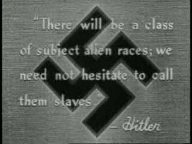 Chapter
III begins with Britain and France's declaration of war on Germany
after Hitler's invasion of Poland. The film covers the Nazi capture of
Denmark and Norway, steps necessary to mount a future attack on Britain,
then describes in detail Hitler's strategy as he conquers Luxembourg, Belgium
and the Netherlands. Chapter
III begins with Britain and France's declaration of war on Germany
after Hitler's invasion of Poland. The film covers the Nazi capture of
Denmark and Norway, steps necessary to mount a future attack on Britain,
then describes in detail Hitler's strategy as he conquers Luxembourg, Belgium
and the Netherlands.
Special attention is paid to Nazi atrocities. Dead and
injured children are shown en masse and the film explains how the bombing
of Rotterdam leads to "thirty thousand men, women and children killed in
ninety minutes."
The narrator tells how the Luftwaffe bombs small villages
so that refugees clog the highways, and how it uses precision machine gun
fire to herd the survivors toward the allied armies, who find their progress
severely constrained as a result. An American military officer details
the Nazi plan for an invasion of France, which Hitler conquers in just
over a month.
The Germans bludgeon the French armies into surrender,
then "enslave" much of the local population to service the German military
regime.
|
4. The Battle of Britain
(1943) (51:30) - depicts Britain's victory against the Luftwaffe.
Watch
Pt. IV at Archive.org
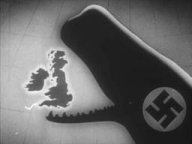 Chapter
IV begins after Hitler's conquest of Western Europe. Once firmly in control
of the parts of France and Norway closest to Great Britain, the Nazis commence
their massive air assault on the British isles. Chapter
IV begins after Hitler's conquest of Western Europe. Once firmly in control
of the parts of France and Norway closest to Great Britain, the Nazis commence
their massive air assault on the British isles.
Outnumbered six to one, the fighters of the Royal Air
Force defend their skies against the Luftwaffe for close to four months.
Capra embellishes the British successes, for example the film claims the
RAF fought 200 dogfights in the first thirty minutes of the battle alone,
and that by the end of the first month they had destroyed 900 German planes.
(In truth, the number is closer to 260).
However, the success of the British defenses forced the
Germans to change strategies, switching to more frightening night raids
that terrorized London. But the British resolve won the day, in grand fashion.
The film claims total German losses of more than 2,700.
The real number is closer to 1,600. The number of downed British planes
equaled approximately half that of Germany.
|
5. The Battle of Russia
(1943) (76:07) part 1, part 2 - shows a history of Russian defense and
Russia's battle against Germany.
Watch
Pt. V - 1 at Archive.org
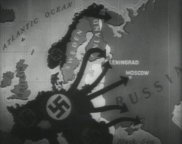 Chapter
V follows the beginning of the end for Adolph Hitler. Part One shows how
the Nazi regime, frustrated by the tenacity of British resistance, sets
its sights on the Soviet Union instead. Chapter
V follows the beginning of the end for Adolph Hitler. Part One shows how
the Nazi regime, frustrated by the tenacity of British resistance, sets
its sights on the Soviet Union instead.
As it follows the Nazi march into Russian territory, the
film provides a brief summary of the attempts of foreign powers to invade
Russia over the past seven hundred years. It explains why the country is
such a hot prize and why no army in history ever succeeded in conquering
it.
Hitler is portrayed as a fool, his hubris blinding him
to the evidence of history. The film illustrates how the Red Army's method
of fighting -- a scorched-earth strategy and a reliance on guerilla and
urban warfare -- was bound to defeat the Nazis as it had defeated every
invader before them. Capra's favorable portrait of the Russians is notable.
Released two years before the start of the Cold War, the
film portrays the Soviets as a diverse and freedom-loving people, in many
ways similar to their then-allies, the people of the United States.
Watch
Pt. V - 2 at Archive.org
Chapter V - Part Two, the German army falls victim to
the Soviet scorched-earth strategy.
The Russian forces flee from the start, retreating deep
into their homeland, drawing the Nazis farther and farther away from the
German border. As the Red Army falls back, it destroys infrastructure and
natural resources, making it difficult for the Nazi army to live off the
land.
Once the famed Russian winter sets in, Germany is doomed.
The film focuses on the stalwart defense of Leningrad. After the Nazis
surround the Soviet metropolis in an attempt to starve out its residents,
the Russians outsmart them by constructing a fully operational railroad
across a frozen lake to get supplies to the beleaguered citizens. The Battle
of Russia ends up as a disaster for the Germans, who lose more than 800,000
men.
|
6. The Battle of China
(1944) (62:16) - shows Japanese aggression such as the Nanking Massacre
and Chinese efforts such as the construction of the Burma Road and the
Battle of Changsha
Watch
Pt. VI at Archive.org
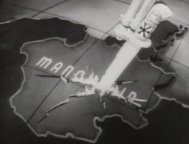 Chapter
VI explains why the Empire of Japan possessed such a strong interest in
ruling the disparate lands of China. In an attempt to break the will of
the Chinese people in one massive assault, Japan invades Nanking and massacres
forty thousand civilians. Chapter
VI explains why the Empire of Japan possessed such a strong interest in
ruling the disparate lands of China. In an attempt to break the will of
the Chinese people in one massive assault, Japan invades Nanking and massacres
forty thousand civilians.
The attack results in an opposite effect, galvanizing
the Chinese resistance and unifying the separate lands into a single Chinese
identity.
While the Japanese take control of all Chinese ports,
hoping to cut off all resources from its victim, China's allies effectuate
an engineering miracle. They construct the seven hundred mile long Burma
Road over the mountains of Myanmar, and set up a constant caravan of trucks
to ship food and materiel to the Chinese armies, keeping them alive.
Frustrated by their inability to conquer China, the Japanese
turn their attention to the islands of the Pacific, and the United States.
|
7. War Comes to America
(1945) (64:20) - shows how the pattern of Axis aggression turned
the American people against isolationism.
Watch
Pt. VII at Archive.org
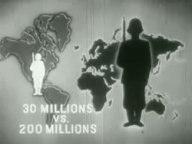 In
this final installment the subject focuses on the United States of America.
We learn of its good qualities and the things worth fighting for. In
this final installment the subject focuses on the United States of America.
We learn of its good qualities and the things worth fighting for.
With that established, we learn of the history of the
United States' population shifting opinion towards siding with the Allies
against the Axis until the attack on Pearl Harbour which brought America
into full scale involvement in the war.
|
YOUTUBE.COM
Shorter clips of the above are available at YouTube.com
. . . for example:
Battle
of China
I | II
| III
| IV
| V
| VI
| VII
|
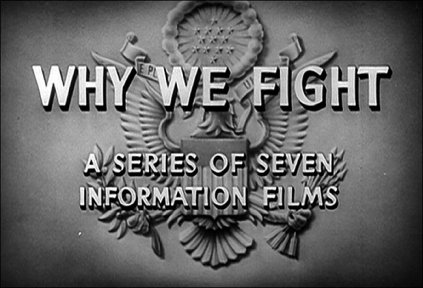
Why We Fight is a series of seven propaganda films commissioned by the United States government during World War II to demonstrate to American soldiers the reason for U.S. involvement in the war. Later on they were also shown to the general U.S. public to persuade them to support American involvement in the war.







